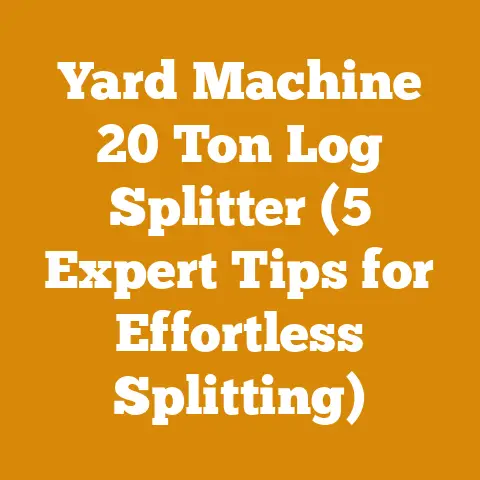Adjusting Carburetor on Stihl Weedeater (Pro Tuning Tips Inside)
Imagine this: You’re battling a relentless swarm of weeds, the sun beating down, and your trusty Stihl weedeater sputters, coughs, and dies. It’s the kind of frustration that can derail an entire afternoon. But what if I told you that instead of throwing your hands up in despair, you could become the master of your machine, fine-tuning its performance with a few simple carburetor adjustments? That’s the transformation I want to guide you through – from frustrated user to empowered mechanic, capable of extracting peak performance from your Stihl weedeater. This article isn’t just about turning screws; it’s about understanding your engine, optimizing its fuel-air mixture, and saving yourself time, money, and a whole lot of aggravation. Let’s dive in.
Adjusting Carburetor on Stihl Weedeater (Pro Tuning Tips Inside)
The carburetor is the heart of your Stihl weedeater, responsible for precisely mixing fuel and air to create the combustion that powers the engine. A poorly adjusted carburetor can lead to a host of problems, from hard starting and poor acceleration to excessive smoke and engine damage. Understanding how to adjust it is crucial for maintaining optimal performance and extending the life of your equipment.
Understanding the Carburetor: A Deep Dive
Before we start turning screws, let’s understand what we’re working with. Most Stihl weedeater carburetors have three adjustment screws:
- High (H): Controls the fuel mixture at high engine speeds.
- Low (L): Controls the fuel mixture at low engine speeds and idle.
- Idle (LA or T): Adjusts the engine’s idle speed.
Newer models often have limiter caps that prevent overly rich or lean adjustments, but understanding their purpose is still essential. Older models might have fully adjustable screws, offering more control but also requiring more precision.
Why is this important? A lean mixture (too much air, not enough fuel) can cause the engine to run hot and potentially damage it. A rich mixture (too much fuel, not enough air) can lead to poor performance, excessive smoke, and fouled spark plugs. Finding the sweet spot is the key.
Assessing the Symptoms: Is Your Carburetor Out of Whack?
Identifying the symptoms is the first step towards a solution. Here are some common signs that your Stihl weedeater’s carburetor needs adjustment:
- Hard Starting: The engine struggles to start, requiring multiple pulls.
- Poor Acceleration: The engine bogs down or hesitates when you try to accelerate.
- Rough Idle: The engine idles unevenly or stalls frequently.
- Excessive Smoke: The engine produces a lot of smoke, especially at high speeds.
- Fouled Spark Plug: The spark plug is black and oily, indicating a rich mixture.
- Engine Overheating: The engine runs hotter than usual, potentially indicating a lean mixture.
My Experience: I remember one summer where my Stihl FS 90R was acting up – hard starting, sputtering, and generally being a pain. I initially suspected the spark plug, but after replacing it, the problem persisted. That’s when I realized the carburetor was the culprit. A little tweaking, and it was back to its old self.
Gathering Your Tools and Preparing Your Workspace
Before you start, gather the necessary tools:
- Screwdriver: A small, flat-head screwdriver is essential for adjusting the carburetor screws. Some carburetors require a special “D” shaped tool, which can be purchased online or at a local small engine repair shop.
- Tachometer (Optional): A tachometer can help you accurately measure the engine’s RPM, allowing for precise idle speed adjustment.
- Spark Plug Wrench: For removing and inspecting the spark plug.
- Carburetor Cleaner: To clean any debris that might be affecting the carburetor’s performance.
- Safety Glasses: To protect your eyes from debris.
- Gloves: To keep your hands clean.
Workspace: Choose a well-ventilated area, away from flammable materials. Ensure the weedeater is on a stable surface and that the engine is cool.
The Adjustment Process: Step-by-Step Guide
Now, let’s get down to the nitty-gritty.
1. Locate the Carburetor Adjustment Screws:
The location of the screws varies depending on the model of your Stihl weedeater, but they are typically found on the side of the carburetor. Refer to your owner’s manual for specific instructions.
2. Initial Settings:
If your carburetor has limiter caps, you may need to remove them to access the full range of adjustment. Typically, limiter caps are designed to be removed by carefully prying them off with a small screwdriver. However, be extremely cautious, as damaging the screw or carburetor body can be costly.
Start by turning both the “H” and “L” screws all the way in (clockwise) until they are lightly seated. Then, back them out to the factory settings. These settings are usually specified in your owner’s manual, but a good starting point is typically 1 turn out for both screws.
3. Starting the Engine:
Start the engine and let it warm up for a few minutes. This will ensure that the engine is at its operating temperature, allowing for more accurate adjustments.
4. Adjusting the Low (L) Speed Screw:
The “L” screw affects the engine’s performance at low speeds and idle.
- Too Lean (Too Much Air): If the engine idles too fast or stalls when you release the throttle, the mixture is likely too lean. Turn the “L” screw counterclockwise (richening the mixture) in small increments (1/8 of a turn) until the engine idles smoothly.
- Too Rich (Too Much Fuel): If the engine idles roughly or produces excessive smoke, the mixture is likely too rich. Turn the “L” screw clockwise (leaning the mixture) in small increments until the engine idles smoothly.
5. Adjusting the Idle (LA or T) Speed Screw:
The idle speed screw controls the engine’s idle speed. The recommended idle speed for most Stihl weedeaters is between 2,500 and 3,000 RPM. Use a tachometer to accurately measure the engine’s RPM.
- Too Low: If the engine stalls at idle, turn the idle speed screw clockwise to increase the idle speed.
- Too High: If the engine’s cutting head spins at idle, turn the idle speed screw counterclockwise to decrease the idle speed.
6. Adjusting the High (H) Speed Screw:
The “H” screw affects the engine’s performance at high speeds. This adjustment is crucial for preventing engine damage.
- Too Lean: A lean mixture at high speeds can cause the engine to overheat and potentially seize. If the engine sounds “tinny” or lacks power at high speeds, the mixture is likely too lean. Turn the “H” screw counterclockwise (richening the mixture) in small increments.
- Too Rich: A rich mixture at high speeds can lead to poor performance and excessive smoke. If the engine bogs down or produces a lot of smoke at high speeds, the mixture is likely too rich. Turn the “H” screw clockwise (leaning the mixture) in small increments.
Important Note: When adjusting the “H” screw, it’s crucial to listen to the engine. You want to find the point where the engine runs smoothly and powerfully without sounding strained or “tinny.” A slight four-stroking sound (a slight hesitation in the engine’s rhythm) at full throttle is often a good indication of a properly adjusted “H” screw.
7. Fine-Tuning and Testing:
After making the initial adjustments, test the weedeater under load (while cutting grass or weeds). Pay attention to how the engine performs at different speeds and make any necessary fine-tuning adjustments.
8. Reinstall Limiter Caps (If Applicable):
If you removed limiter caps, reinstall them after you’ve completed the adjustments. This will help prevent you from accidentally making overly rich or lean adjustments in the future.
Carburetor Adjustment: A Case Study
Let’s say I’m working on a Stihl FS 56 RC-E that’s exhibiting hard starting and poor acceleration. I’ve already checked the spark plug and air filter, and they’re both in good condition. I suspect the carburetor needs adjustment.
- Locate the Screws: I find the “H,” “L,” and “LA” screws on the side of the carburetor.
- Initial Settings: I turn both the “H” and “L” screws in until they are lightly seated, then back them out 1 turn each (the recommended factory setting for this model).
- Start the Engine: The engine starts after a few pulls but idles roughly.
- Adjust the “L” Screw: I turn the “L” screw counterclockwise in small increments until the engine idles smoothly.
- Adjust the “LA” Screw: The engine idles too fast, so I turn the “LA” screw counterclockwise until the idle speed is around 2,800 RPM (using a tachometer).
- Adjust the “H” Screw: I run the engine at full throttle and listen carefully. It sounds slightly “tinny,” so I turn the “H” screw counterclockwise in small increments until the engine runs smoothly and powerfully.
- Test and Fine-Tune: I test the weedeater while cutting grass. It accelerates smoothly and runs well at all speeds. I make a few minor adjustments to the “L” and “H” screws to optimize performance.
The result? A Stihl FS 56 RC-E that starts easily, accelerates smoothly, and runs like a champ.
Dealing with Limiter Caps: A Delicate Operation
As mentioned earlier, newer Stihl weedeaters often have limiter caps on the carburetor adjustment screws. These caps restrict the range of adjustment, preventing overly rich or lean mixtures.
Removing Limiter Caps:
If you need to remove the limiter caps to access the full range of adjustment, proceed with caution.
- Identify the Cap Type: Some caps are simply pressed onto the screw, while others are held in place by a small tab.
- Use a Small Screwdriver: Carefully pry the cap off the screw, being careful not to damage the screw or carburetor body.
- Apply Gentle Pressure: If the cap is held in place by a tab, use the screwdriver to gently depress the tab while prying the cap off.
Important Note: Removing the limiter caps can void the warranty on your Stihl weedeater. If you’re not comfortable with this procedure, it’s best to take your weedeater to a qualified service technician.
Troubleshooting Common Carburetor Problems
Even with careful adjustment, you may encounter some common carburetor problems. Here are some troubleshooting tips:
- Engine Still Runs Poorly After Adjustment:
- Check the Fuel Filter: A clogged fuel filter can restrict fuel flow, causing poor performance.
- Clean the Carburetor: Dirt and debris can clog the carburetor jets, affecting its performance. Use carburetor cleaner to thoroughly clean the carburetor.
- Check for Air Leaks: Air leaks in the intake manifold or carburetor gaskets can cause a lean mixture.
- Engine Floods Easily:
- Check the Needle Valve: A faulty needle valve can allow too much fuel into the carburetor, causing the engine to flood.
- Adjust the Float Level: The float level controls the amount of fuel in the carburetor bowl. If the float level is too high, the engine may flood.
- Engine Won’t Start:
- Check the Spark Plug: A fouled or damaged spark plug can prevent the engine from starting.
- Check the Ignition Coil: A faulty ignition coil can prevent the spark plug from firing.
- Check the Compression: Low compression can make it difficult to start the engine.
Maintenance: Keeping Your Carburetor in Top Shape
Preventive maintenance is key to keeping your Stihl weedeater’s carburetor in top shape.
- Use Fresh Fuel: Always use fresh, high-quality fuel. Old fuel can gum up the carburetor jets.
- Use Fuel Stabilizer: If you’re not going to use your weedeater for an extended period, add fuel stabilizer to the fuel tank. This will help prevent the fuel from breaking down and clogging the carburetor.
- Clean the Air Filter Regularly: A dirty air filter can restrict airflow, causing the engine to run poorly. Clean the air filter regularly with soap and water.
- Inspect the Fuel Lines: Check the fuel lines for cracks or leaks. Replace any damaged fuel lines.
- Clean the Carburetor Periodically: Even with proper maintenance, the carburetor can still become clogged with dirt and debris over time. Clean the carburetor periodically with carburetor cleaner.
Cost Considerations: DIY vs. Professional Repair
Adjusting a carburetor is a task that many homeowners can tackle themselves, saving money on professional repairs. However, it’s essential to weigh the costs and benefits of DIY versus professional service.
DIY Carburetor Adjustment:
- Pros:
- Cost Savings: You’ll save money on labor costs.
- Convenience: You can adjust the carburetor at your own pace and on your own schedule.
- Learning Opportunity: You’ll gain a better understanding of how your weedeater works.
- Cons:
- Risk of Damage: If you’re not careful, you could damage the carburetor or other engine components.
- Time Investment: It can take time to properly adjust the carburetor, especially if you’re not familiar with the process.
- Potential for Frustration: If you’re having trouble, it can be frustrating to troubleshoot the problem.
Professional Carburetor Repair:
- Pros:
- Expertise: A qualified service technician has the knowledge and experience to properly diagnose and repair carburetor problems.
- Warranty: Many repair shops offer a warranty on their work.
- Convenience: You can drop off your weedeater at the repair shop and let them handle the problem.
- Cons:
- Cost: Professional repairs can be expensive.
- Inconvenience: You’ll have to take your weedeater to the repair shop and wait for it to be fixed.
Cost Breakdown:
Let’s consider a scenario where your Stihl weedeater is running poorly, and you suspect the carburetor needs adjustment.
-
DIY:
- Carburetor Cleaner: \$10 – \$20
- Screwdriver Set (if needed): \$15 – \$30
- Tachometer (optional): \$30 – \$100
- Total Cost: \$55 – \$150
-
Professional Repair:
- Diagnostic Fee: \$30 – \$50
- Labor: \$50 – \$100 per hour
- Parts (if needed): \$20 – \$50
- Total Cost: \$100 – \$200+
My Recommendation:
If you’re comfortable working on small engines and have the necessary tools, adjusting the carburetor yourself can be a cost-effective option. However, if you’re not confident in your abilities or if the problem is more complex, it’s best to take your weedeater to a qualified service technician.
Carburetor Replacement: When Adjustment Isn’t Enough
In some cases, adjusting the carburetor may not be enough to solve the problem. If the carburetor is severely damaged or worn, it may need to be replaced.
Signs That Your Carburetor Needs Replacement:
- Cracked or Damaged Carburetor Body: If the carburetor body is cracked or damaged, it can leak air and fuel, causing poor performance.
- Worn Throttle Shaft: A worn throttle shaft can cause the throttle to stick or bind.
- Damaged Needle Valve Seat: A damaged needle valve seat can cause the engine to flood.
- Corroded or Clogged Jets: Severely corroded or clogged jets may not be able to be cleaned effectively.
Cost of Carburetor Replacement:
The cost of replacing a carburetor varies depending on the model of your Stihl weedeater and whether you do it yourself or hire a professional.
-
DIY:
- Carburetor (Replacement Part): \$30 – \$80
- Tools (if needed): \$15 – \$30
- Total Cost: \$45 – \$110
-
Professional Replacement:
- Carburetor (Replacement Part): \$30 – \$80
- Labor: \$50 – \$100 per hour
- Total Cost: \$80 – \$200+
My Recommendation:
Replacing a carburetor is a relatively straightforward task that most homeowners can handle themselves. However, it’s essential to use the correct replacement part and to follow the manufacturer’s instructions carefully. If you’re not comfortable with this procedure, it’s best to take your weedeater to a qualified service technician.
Fuel and Oil Ratios: Getting It Right
The correct fuel and oil ratio is crucial for the health of your Stihl weedeater’s engine. Using the wrong ratio can lead to engine damage.
Stihl Weedeater Fuel and Oil Ratio:
Most Stihl weedeaters require a fuel and oil ratio of 50:1. This means that you need to mix 50 parts of gasoline with 1 part of 2-cycle engine oil.
Using the Correct Oil:
It’s essential to use a high-quality 2-cycle engine oil that is specifically designed for air-cooled engines. Stihl recommends using Stihl HP Ultra oil, which is a synthetic oil that provides excellent lubrication and protection.
Mixing Fuel and Oil:
- Use a Clean Container: Use a clean, approved fuel container.
- Add Gasoline First: Add the correct amount of gasoline to the container.
- Add Oil: Add the correct amount of 2-cycle engine oil to the container.
- Mix Thoroughly: Mix the fuel and oil thoroughly by shaking the container for at least 30 seconds.
Example:
If you’re mixing 1 gallon (128 ounces) of gasoline, you’ll need to add 2.6 ounces of 2-cycle engine oil to achieve a 50:1 ratio (128 ounces / 50 = 2.56 ounces).
Why is this important? Using too little oil can lead to engine damage due to insufficient lubrication. Using too much oil can lead to excessive smoke and fouled spark plugs.
Understanding Octane Ratings: Fueling Performance
The octane rating of gasoline is a measure of its resistance to knocking or pinging. Using the correct octane rating is important for optimal engine performance.
Stihl Weedeater Octane Rating:
Stihl recommends using gasoline with an octane rating of 89 or higher in its weedeaters.
Why is this important? Using gasoline with a lower octane rating than recommended can cause the engine to knock or ping, which can damage the engine over time.
Ethanol Content:
Ethanol is an alcohol that is often added to gasoline. While ethanol can increase the octane rating of gasoline, it can also damage small engines.
Stihl’s Recommendation:
Stihl recommends using gasoline with an ethanol content of no more than 10%. If you can’t find gasoline with an ethanol content of 10% or less, Stihl recommends using a fuel stabilizer that is specifically designed to protect against the harmful effects of ethanol.
Spark Plug Inspection and Maintenance: A Critical Component
The spark plug is a critical component of your Stihl weedeater’s engine. It’s responsible for igniting the fuel-air mixture in the combustion chamber. A faulty spark plug can cause a variety of problems, including hard starting, poor performance, and engine misfires.
Inspecting the Spark Plug:
Inspect the spark plug regularly for signs of wear or damage.
- Electrode Wear: Check the electrode for wear or erosion. If the electrode is worn, the spark plug should be replaced.
- Cracked Insulator: Check the insulator for cracks or chips. If the insulator is cracked, the spark plug should be replaced.
- Fouling: Check the spark plug for fouling (deposits of carbon or oil). If the spark plug is fouled, it should be cleaned or replaced.
Cleaning the Spark Plug:
If the spark plug is fouled, you can try cleaning it with a wire brush or spark plug cleaner. However, if the spark plug is heavily fouled or damaged, it should be replaced.
Replacing the Spark Plug:
Replace the spark plug according to the manufacturer’s recommendations. The spark plug gap (the distance between the electrode and the ground electrode) should be set to the manufacturer’s specifications.
Cost of Spark Plug Replacement:
The cost of replacing a spark plug is relatively low. A new spark plug typically costs between \$5 and \$10.
Air Filter Maintenance: Breathing Easy
The air filter is responsible for preventing dirt and debris from entering the engine. A dirty air filter can restrict airflow, causing the engine to run poorly.
Cleaning the Air Filter:
Clean the air filter regularly with soap and water. Allow the air filter to dry completely before reinstalling it.
Replacing the Air Filter:
Replace the air filter according to the manufacturer’s recommendations.
Cost of Air Filter Replacement:
The cost of replacing an air filter is relatively low. A new air filter typically costs between \$5 and \$15.
Seasonal Adjustments: Adapting to the Weather
The air density changes with the seasons, which can affect the performance of your Stihl weedeater. In general, the air is denser in the winter than in the summer.
Winter Adjustments:
In the winter, the air is denser, which means that the engine will run leaner. You may need to richen the mixture by turning the “H” and “L” screws counterclockwise slightly.
Summer Adjustments:
In the summer, the air is less dense, which means that the engine will run richer. You may need to lean the mixture by turning the “H” and “L” screws clockwise slightly.
My Experience: I’ve noticed a significant difference in my weedeater’s performance between summer and winter. In the summer, it tends to run a bit richer, and I often need to lean the mixture slightly to prevent it from bogging down. In the winter, it tends to run leaner, and I often need to richen the mixture slightly to prevent it from overheating.
Budgeting for Stihl Weedeater Maintenance: A Long-Term Perspective
Maintaining your Stihl weedeater is essential for extending its lifespan and ensuring optimal performance. Creating a budget for maintenance can help you avoid unexpected expenses and keep your equipment running smoothly.
Annual Maintenance Budget:
Here’s a sample annual maintenance budget for a Stihl weedeater:
- Spark Plug Replacement: \$10
- Air Filter Replacement: \$10
- Fuel Filter Replacement: \$10
- Carburetor Cleaner: \$15
- 2-Cycle Engine Oil: \$20
- Fuel Stabilizer: \$10
- Total Annual Maintenance Cost: \$75
Long-Term Maintenance Costs:
Over the lifespan of your Stihl weedeater, you can expect to spend several hundred dollars on maintenance. However, by performing regular maintenance and addressing problems promptly, you can extend the lifespan of your equipment and avoid costly repairs.
Final Thoughts: Mastering Your Machine
Adjusting the carburetor on your Stihl weedeater may seem daunting at first, but with a little knowledge and patience, it’s a task that most homeowners can handle themselves. By understanding the carburetor’s function, identifying the symptoms of a poorly adjusted carburetor, and following the step-by-step instructions in this article, you can fine-tune your weedeater’s performance and keep it running smoothly for years to come. Remember to prioritize safety, use the correct tools, and don’t be afraid to experiment (within reason) to find the sweet spot for your engine. And if you ever feel overwhelmed, don’t hesitate to seek the help of a qualified service technician. Now go out there and conquer those weeds!






